Wyrmwood Modular Wargaming Table
A day I've been waiting two years to arrive finally came: the delivery of the Wyrmwood war gaming table I ordered.
Ellen and I were in the middle of planning our long-desired renovations to the kitchen and dining room when Wyrmwood launched its Kickstarter for its tables back in 2020. I sorta offhandedly mentioned there was a Kickstarter about to launch for some cool custom tables purpose-built for gaming, mostly to point out the outer reaches of the hobby's accoutrements. I was going to have her quickly look at the website over my shoulder and then let it drop entirely. Much to my surprise she immediately suggested we get one and just roll it into our budget for the home renovations.
Ellen has always been completely supportive of my hobby, seeing how much pleasure it brings me, but even I was taken aback by her willingness to suggest we make this not-insubstantial purchase. I'll say it here again: she's the best.
I would never have even pointed out the table if I wasn't confident that it was actually a sturdy, well-crafted piece of furniture, something we would actually like having in our dining room when it wasn't configured for a game day. It will actually allow us to seat eight guests for dinner, something we enjoy hosting.
But on the second Saturday of each month, our dining room gets transformed into Scrum Hall, and we now have the Cadillac of gaming tables on which to play out our flights of miniature fancy. I bought enough of the accoutrements to accommodate eight players, so each player has their own glass holder and game piece tray, both of which attach magnetically either to the outside of the table or inside the 4" deep vault that's accessible once the table's sectional top is removed. I anticipate this will help a lot with policing the stray dice and tape measures that usually end up scattered around the table, an eyesore that detracts from the photos we all like to take of the games in progress.
I also picked up a couple of different felt mats cut to fit, as well as a wet-marker erasable hex and grid mat that covers the entire 4'x6' vault. I even sprung for the acrylic overlays that can be used to keep paper game boards and the like flat during play. As somebody with a fondness for and decent collection of old SPI and Avalon Hill games, the acrylic overlay in a nifty feature for those folded-up paper game boards.
My longtime pisano and fellow Scrum Clubber Francesco came over the evening it was delivered, and we set about putting it together. It arrived the Tuesday before Historicon, and I thought I would just wait until after the convention to assemble the table, but excitement got the better of me, and Francesco was more than game to come over that very night. He couldn't wait for my table to arrive so he could "practice" on assembling mine while he waits another two months for his own to arrive. All said, it came together in about two hours, and if you get one, I advise watching the video beforehand as well as have an iPad handy in order to consult it when the paper directions are too vague. For larger tables like mine (Wyrmwood makes smaller ones), it most definitely requires two people to put together, and I'd suggest three or four for the couple of times in the process in which you have to flip the table over without damaging the legs. This table is quite heavy.
 |
| Cha-Cha giving the newly arrived boxes--11 in all--a thorough cat scan. |
 |
| The grid mat (hexes on the reverse). One square = one cat paw. |
 |
The attachable desk.
Some people go crazy and buy several of these for their table, but I bought just one, specifically for the GM when we play RPGs. It has a groove in the front for attaching a GM screen if desired. |
 |
| Drink holder and component tray. These attach magnetically inside or outside the vault along a rail that winds along the entire circumference of the table. |
 |
| An extra felt mat, this one in red in case I want to switch things up. |
You can find more photos of the table below in the discussion of the first game we played on it.
Dire Tidings at Klanên-Rühen
My wife Ellen suggested I invite some friends over to christen the new table with a game last weekend. I was a little surprised given I had just spent four days the weekend before at Historicon, but I was eager to try out the table, so I didn't hesitate.
I put the call out to the Scrum Club and our auxiliary, with Jared, Steve, Francesco, and Joey McGuire responding they were free to come over. I didn't have a game in mind, but I wanted the first one on the new table to be something of my own devising, and saw it as an opportunity to put some terrain on the table with which I had never had a chance to play, namely a large Dwarven fortress I've owned since around 2018 by the German company
Ziterdes. That said, I still needed to decide what rules we'd use and to come up with a scenario.
I opted to use the
Thud & Blunder rules out of expediency. The Scrum Club has been using them since late spring for a monthly campaign we're playing (which I'm woefully remiss in posting about), which meant I'd only have to teach the rules to Joey (given that he is a game designer himself--see
This Is Not a Test--I knew he'd pick them up quickly). Some of the Scrum Clubbers like the rules more than others; I fall into the camp that thinks they work really well for fantasy skirmish games and do everything I need them to do with a minimum of fussiness. I'll start a series of blog posts soon that catches up to where we are in our monthly campaign, which is slated to go through September.
This, however, was a noncampaign game, and I told the players to create warbands of around 250-260 points, building from the lists in the rulebook. I have a fondness for miniatures games conducted by a game master, likely a throwback to my role-playing game roots, and I concocted a scenario that put me loosely in that role. I played the foes (with Francesco's help) that the other players would face over the course of the game, which included a variety of orcs as well as ogres, minotaurs, hill giants, and warg-riding goblins. I kept everything but the orcs off the table at the start, wanting some of the more fearsome foes to be surprises for later in the game.
I like building in some randomness in my scenarios, too, and in this scenario that unpredictability involved randomizing what foes would appear each round and where, whether the players would get reinforcements from the fortress each round, what boons the various dwarven burial mounds would bestow on players, and finally how long it would take the players to convince the Dwarven princess that the news they carried was true and that she need to act quickly. Read below for the scenario's description and the various rules I used to add flavor to it.
The Story Thus Far...
With King Osrin entombed for less than a year, the Sea Fortress of Klanên-Rühen is now jointly overseen by his scions, the siblings Prince Fenrod and Princess Ravina. As is the custom, at the one-year anniversary of their father’s death, the clan council will choose one of them to fill Osrin’s role as ruler of Klanên-Rühen, which also means taking his seat on the Council of Free Peoples.
A fortnight ago, Fenrod began the pilgrimage as Klanên-Rühen’s interim representative at the Council of Free Peoples’ triennial conclave, leaving his sister to oversee the sea fortress.
Fenrod never arrived at the conclave.
Unbeknownst to his sister and the people of Klanên-Rühen, Prince Fenrod and his band of ambassadors were set upon by the Bludglote, a tribe of Orcs not seen outside of the Borderlands in two hundred years. Fenrod and his companions fell to the attackers just as the Bludglote were driven off by a patrol of Free Peoples. Interrogating a Bludglote straggler revealed a force was being amassed to lay siege to Klanên-Rühen in its time of vulnerability. Princess Ravina would need to make her own pilgrimage to the Council to solicit their help in fending off such a siege.
Urgency dictates swift action…but reaching Klanên-Rühen before the Bludglote army arrives, convincing Ravina that her beloved brother has indeed fallen, and persuading her that she must immediately leave her people behind to make the pilgrimage to beseech the Council for its help will be no easy task.
Your band has been sent in haste with the fallen Prince’s signet ring to present to Ravina. You will need to reach the fortress and convince her to flee by sail to the Council with her pleas for aid before the Bludglote army can amass at her gates.
Convincing Ravina that Her Brother Has Fallen and that She Must Leave Her Clan Behind to Seek Help
A player's figure must be in base contact with Ravina, who will not leave the fortress (but will meet visitors at the gate). Roll of 10+ required to convince her that her brother is dead and that she must leave her clan behind at Klanên-Rühen by sailing to the Free People’s Council herself. If their first attempt doesn't succeed, the player's can try again every new round. The odds of convincing her improve by +1 each round spent persuading her; +1 if a dwarf is part of the conversation; and +3 if her brother’s signet ring is presented to her.
Burial Mounds of the Dwarven Kings
Designate four burial mounds of the dwarven kings spread around on the table. Any Free Peoples' warband that pays their respects to the dwarven lords of old gets one of these bonuses (designate a number for each of the burial sites).
1: You find a group of three dwarves paying their respects (they immediately join your warband).
2: You find a Horn of Calling hanging at the tomb’s gate. Can be used to summon a group of reinforcements from the Sea Fortress.
3: You read an inspiring inscription reminding the warband of the true meaning of valor, giving them 3 fortune tokens (four if a dwarf reads the inscription) that can be used for rerolls by the whole warband.
4: Dipping one weapon in the pool at this shrine enchants it, improving its Destiny Modifier by another –2.
Adding Foes Each Round
Roll at the at the end of each turn. First roll d6 for the location as designated on table (usually touching woods, rocky outcroppings, other terrain); cannot repeat a location until all six locations have been cycled through; re-roll as necessary. After all locations cycled through once, foes can appear in any location rolled in subsequent rounds. Then roll a d10 for the type of foe (see below).
1 = No Bludglote reinforcements
2-3 = Orc captain + 2 warriors +1 bow
4-5 = Orc captain + 1 warrior + 2 bow
6 = Minotaur + 1 orc warrior + 1 orc bow
7-8 = Ogre + 1 orc warrior + 1 orc bow
9-10 = Hill Giant (must be in base contact with woods or rock outcroppings/fortress to throw boulders)
Dwarven Reinforcements from the Fortress
At the end of every turn, players need to roll a 10+ to get reinforcements from the fortress. Add a dwarf leader’s bonus if any player has one; if a roll fails, add +1 to the roll every subsequent round until a reinforcements roll succeeds, but then the target number resets to 9+ once a group of reinforcements is activated. If a reinforcement roll is successful, let players choose three dwarf figures from fortress to represent a hero, warrior, and crossbowmen, and place them outside the dwarf gate. They will now be activated by the players as an additional warband at their disposal. Several rounds of reinforcements may appear throughout the game, depending on the player's rolls.
Crossbow Cover Fire from Fortress
Players may take three crossbow shots from the fortress at any foes in range (18”) at the end of every “Shoot” phase.
Warg Riders at Round Six
At the end of round six, a boat of six goblin warg riders appears on the shore near the castle and they charge toward the players’ warbands.
The photos below are not in the order of game play, and are offered as an illustration of what our game felt like that evening. These photos should also provide a sense of the new table in action. Most of the photos below are by my lovely wife, though a few are by myself and Jared.
Click on any of them to enlarge.
 |
| I end up creating my own quick-reference sheet for almost every game I put on the table. I've yet to find one in a published ruleset that I like. They're usually too verbose, poorly laid out, and physically unwieldy in size, cluttering up the table. I always aim for nothing larger than a half-page in size (double sided when necessary). |
 |
| Damn, I'm loving these trays for keeping dice and whatnot off the table. |
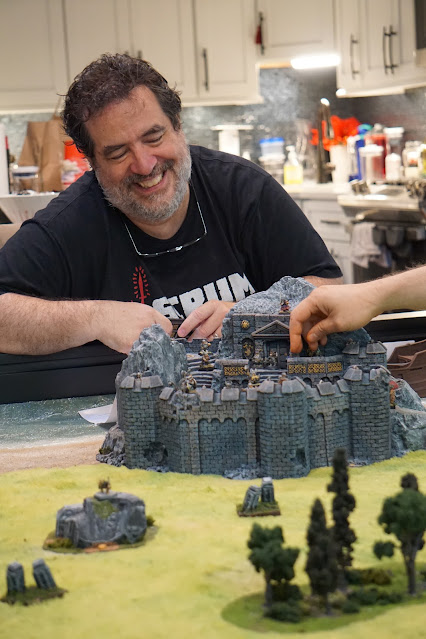 |
| Your humble scribe and the game's GM. I enjoyed watching which miniatures the players chose from the fortress to represent their reinforcements. I had yet to have the chance to put almost any of these dwarves on a table, so it was fun seeing them finally get some game time. |
 |
| A box of baddies for me to draw from. I kept the minotaur, giants, warg riders, etc. tucked away in another box on the bookshelf so the players didn't see them coming. |
 |
| One of Steve's Elven warriors. |
 |
| One of the dwarven lords' burial mounds on the table. Pay your respects, receive a boon. |
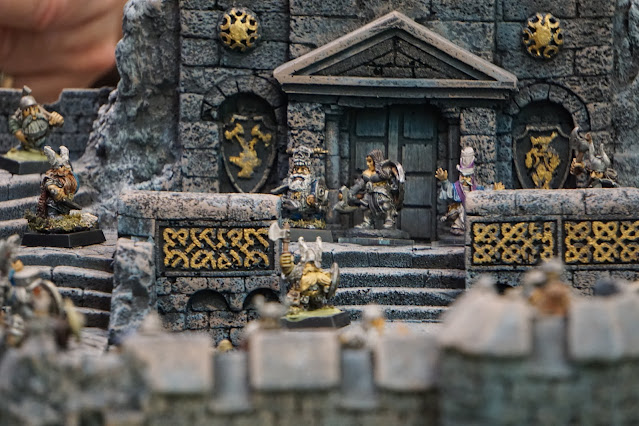 |
| Princess Ravina and her council inside the sea fortress. |
 |
| Francesco, Joey, and Jared (left to right). |
 |
| A lonely dwarf tending the fire at the base of the fortress. |
 |
| A couple of dwarf snipers outside the fortress overseeing the road up to the gate. |
 |
| Some of Jared's brigands finishing off an orc. |
 |
| Some dwarven reinforcements exit the fortress to help out. |
 |
| Orcs taking the high ground. |
 |
| Dwarven warband running as fast as they can with the signet ring toward the fortress. Many fell along the way. |
 |
| Orcs waiting in ambush. |
 |
| Dwarven general surveying the battle. |
 |
| Dwarven reinforcements from the fortress heading toward an orc warband. |
 |
| Goblin archers felled another of Joey's dwarves. |
 |
| Princess Ravina seeking council from a general. |
 |
| Faceoff. |
 |
| Who will win this duel in the glade? |
 |
| The ship behind the fortress is the one the players will need to convince Ravina to embark upon in order to meet the scenarios victory conditions. |
 |
| Jared's warband facing some oncoming orcs. |
 |
| The battle at the burial site! |
 |
| Damn my eyes! Is that a hill giant emerging from the woods! |
 |
| The hill giant throws a tree that lands atop one of Jared's brigands. |
 |
| You will know us by the trail of dead! |
 |
| The hill giant charges forward to start bashing stuff. |
 |
| Wait! What's that ship coming ashore in the distance? It's not a trading vessel... |
 |
| Blast it! Warg riders disembark and race toward our beset heroes! |
 |
| An ogre joins the hill giant in the battle. |
 |
| Lots of little skirmishes in the latter part of the game happening all over the table. |
 |
| The hill giant is slain! The spirits of the dwarven lords smiled upon these warriors today. But the ogre will have something to say about that (though not much, because the heroes eventually took him down, too). |
Closing Thoughts and Parting Shots
One of the benefits of having a game master in the mix is that they can slyly adjust the difficulty level up or down as the game proceeds. It's helpful when playing a system that you're still coming to grips with and an untested scenario that you're not completely confident is balanced. I did a little of that in this game, but frankly not much: the players had some very lucky rolls for recruiting dwarven reinforcements from the fortress that took care of a lot of the foes that would have been in their path otherwise. I never fudge die rolls as a GM, but I did decide on the fly that when I added orc foes on rolls of 2-3 and 4-5 I put out one less figure than called for. Once I actually saw the figures the players fielded in the game, I feared their relatively smallish 250-point warbands might get hopelessly swamped with that many foes joining the fray each round.
All in all, I think it was a good game and a solid scenario. A couple of the players said they'd happily play it again without any adjustments. In the end, after about three hours of play we had to conclude for the night, so as GM I assessed what would have needed to happen for the players to emerge victorious. We rolled some dice to represent the key events for the next handful of rounds (foes spawned and where, how long it would take the players to convince Ravina to leave her fortress, etc.), and I think the players would have eked out a victory, all else equal (e.g., no catastrophically poor combat rolls by the players, etc.).
As for the new table, it was just lovely to play on. Everything was easier to manage, no dice were getting rolled off the table, no miniatures fell to the floor, everything was a bit easier to see in the sunken vault compared to when it sat higher atop the table, drinks were kept away from terrain and playmats...it just felt good to play on a nice piece of furniture purpose-built for gaming. I'm looking forward to making many years of memories on this table. We found a new home for the old dining room table--itself a really sturdy, nice piece of furniture--with a lovely neighborhood couple who could put it to good use. Everybody won in some sense, which is how I like it.
 |
| Our old dining room table on the back deck about to go off to its new home. |








































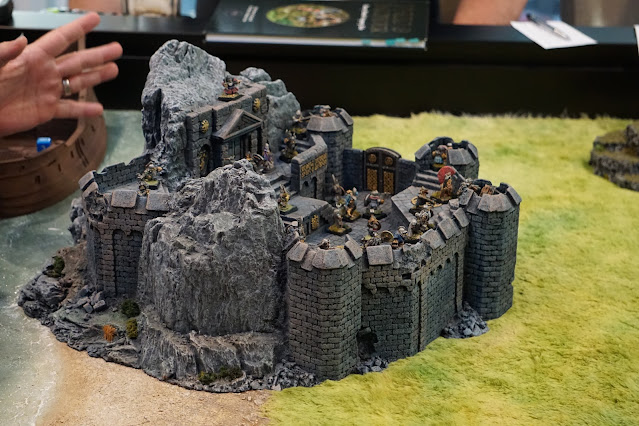




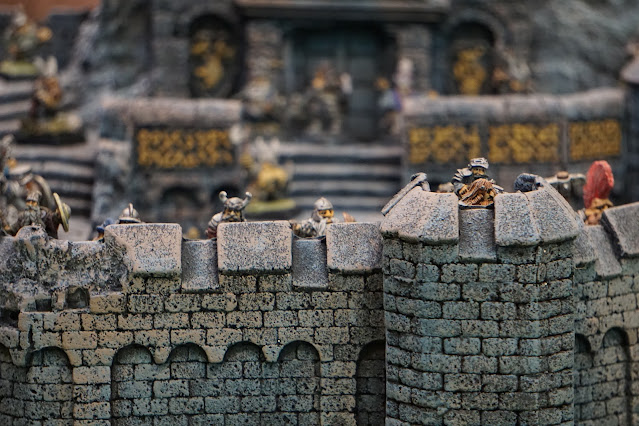











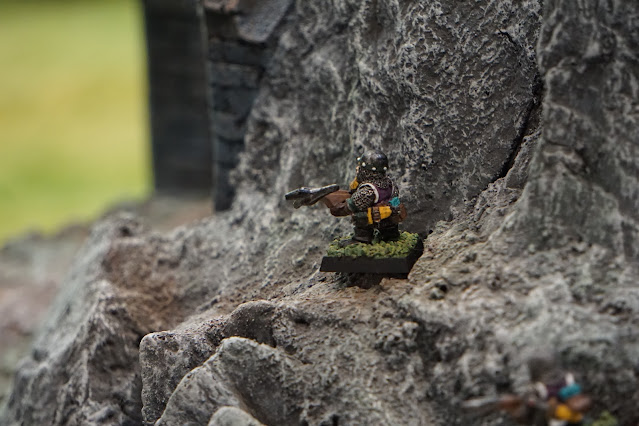


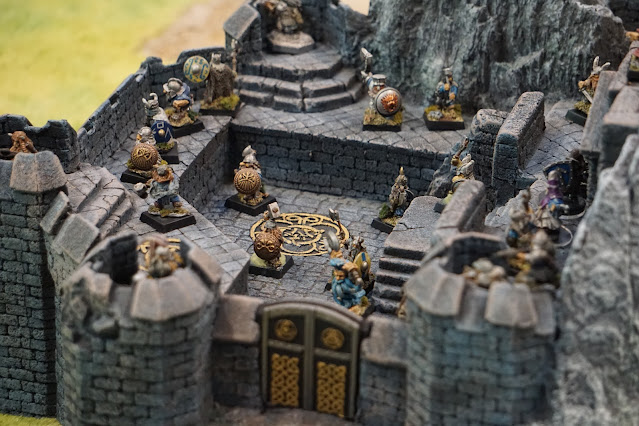

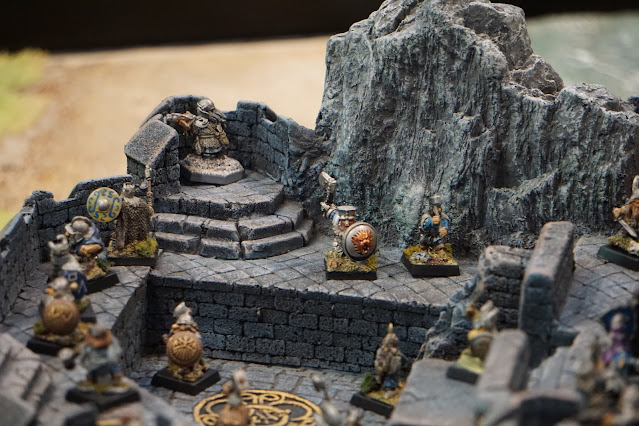










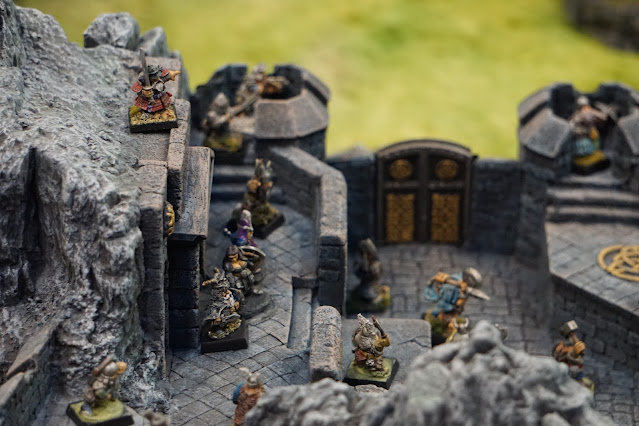



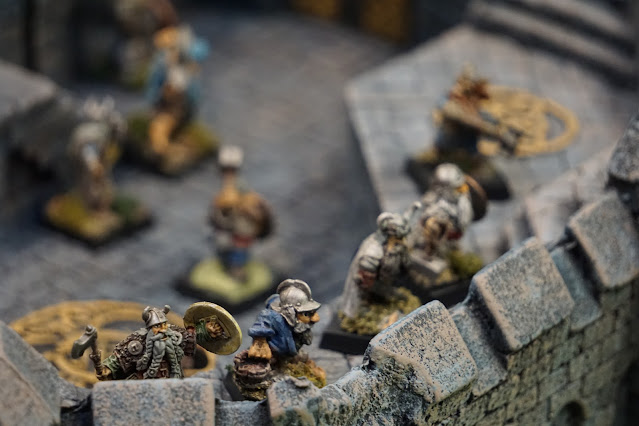






















Splendid looking game, the table looks to have worked really well, the sea fort is a lovely bit of terrain and the old school figures are very evocative, lovely!
ReplyDeleteBest Iain